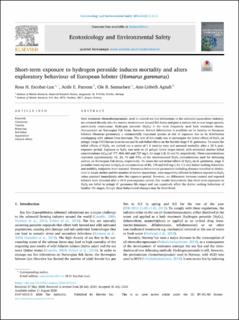| dc.description.abstract | Bath treatment chemotherapeutants, used to control sea lice infestations in the salmonid aquaculture industry, are released directly into the marine environment around fish farms and pose a serious risk to non-target species, particularly crustaceans. Hydrogen peroxide (H2O2) is the most frequently used bath treatment chemotherapeutant on Norwegian fish farms, however, limited information is available on its toxicity to European lobsters (Homarus gammarus), a commercially important species at risk of exposure due to its distribution overlapping with salmon farm locations. The aim of this study was to investigate the lethal effects of H2O2 on pelagic (stage I-IV) larvae/post-larvae and its sub-lethal effects on the benthic stage V H. gammarus. To assess the lethal effects of H2O2, we carried out a series of 1 h toxicity tests and assessed mortality after a 24 h post-exposure period. Exposure to H2O2 was toxic to all pelagic larval stages tested, with estimated median lethal concentrations (LC50) of 177, 404, 665 and 737 mg/L for stage I, II, III and IV, respectively. These concentrations represent approximately 10, 23, 40 and 43%, of the recommended H2O2 concentrations used for delousing salmon on Norwegian fish farms, respectively. To assess the sub-lethal effects of H2O2 on H. gammarus, stage V juveniles were exposed to H2O2 at concentrations of 85, 170 and 510 mg/L for 1 h and shelter-seeking behaviour and mobility endpoints were assessed. Numerous behavioural parameters including distance travelled to shelter, time to locate shelter and the number of shelter inspections, were negatively affected in lobsters exposed to H2O2 when assessed immediately after the exposure period. However, no differences between control and exposed lobsters were detected after a 24 h post-exposure period. Our results demonstrate that short term exposures to H2O2 are lethal to pelagic H. gammarus life stages and can negatively affect the shelter seeking behaviour of benthic life stages, though these behavioural changes may be short-lived. | en_US |
